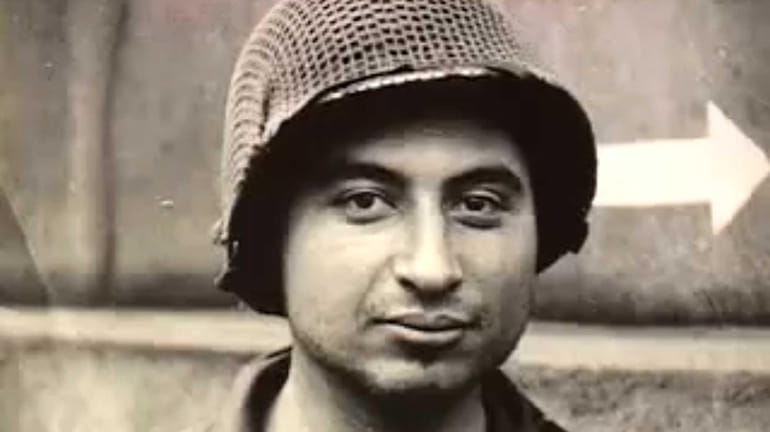World War II vet shares photos from battlefield

A photo of Murray Leff as a soldier Credit: Handout
As his infantry unit pushed into Germany in March and April of 1945, Murray Leff would pull a folding Welti camera from beneath his heavy coat and take photographs of the horrors around him.
One photograph was from within a foxhole, where soldiers close enough for him to touch crouched in shin-deep water during an artillery barrage along the Rhine River.
Another photograph, one of a collection he displayed Monday during a presentation at the Manhasset Public Library, is of a German soldier who lay dead in a field after being shot by one of Leff's platoon mates. By the dead soldier's side lay a photograph of the German as a civilian, wearing a tie and jacket.
Photography by infantrymen was a forbidden battlefield pastime, Leff acknowledges now, but one he says helped him cope with the horror of having death unfold all around him.
"It was my way of recording history," said Leff, who published his photographs in a 2007 account of his war experience, "Lens of an Infantryman: A World War II Memoir With Photographs From A Hidden Camera." "And it was a distraction for me. I could look at things I did not want to see."
As America copes with another generation of soldiers returning from war, programs at veterans and military facilities across the country have begun to use photography and video projects as a way of encouraging patients with post-traumatic stress disorder to address their emotions and battle experiences.
A project organized two years ago by New York documentary filmmaker Benjamin Patton, grandson of fabled World War II Gen. George Patton, has soldiers at Fort Carson, Colo., address their feelings on video. Patton said participants in the program who fought in Iraq and Afghanistan have reported sharply lower symptoms of post-traumatic stress disorder.
"It's empowering," said Patton, who said a similar program will begin at Fort Bragg, N.C., in two weeks. "Just as writing has been shown to help, we're encouraging them to put down the pencil and take up video. It's the medium of this generation of warriors."
Grim realities
For Leff, his use of a camera was one way to help him process war's grim experiences. One photograph he took is of a tank commander with the all-black 784th Tank Battalion, who had rushed to Leff's rescue with a nonchalant "Need help?" and who was killed the next day when a German shell pierced his tank's armor.
"I think of my pictures as a time machine," said Leff, 92, who in 1950 purchased a home in Bellerose, Queens, on the GI Bill, raised two daughters, and has lived there ever since. "Time stopped for me that moment. From a distance of 70 years, I can go back to that 1/25th of a second."
Uncommon art
World War II images as seen through the eyes of ordinary American infantrymen are relatively uncommon, said Anne Wilkes Tucker, a curator for photography at the Museum of Fine Arts, Houston.
Told of Leff's collection, Tucker said most battlefront photography available today was produced by war journalists or uniformed photographers designated by military leaders.
"His is a soldier's eye view, which is not what usually gets reported," said Tucker, who helped organize "War/Photography: Images of Armed Conflict and its Aftermath," an exhibit currently at the Brooklyn Museum through Feb. 2. "It's a personal diary of something quite extraordinary."
Painful losses
Leff, a former advertising executive who works out on a treadmill daily, began taking pictures as a teenager in Williamsburg, Brooklyn. After washing out of an ROTC program at the City University of New York, he was sent to Europe as an infantry rifleman in September 1944.
His first encounter with death shook him deeply. The night before a November battle in France, his squad leader, whom he remembers only as Sgt. Rich, suggested that those who wanted to pray take the time to do it then, because they might not all survive. The next morning, a mortar shell claimed the sergeant as the squad's only casualty that day.
"It was a very traumatic moment for me -- I was young, and had never known anyone who had ever died," Leff recalled. "I just walked around saying his name over and over: 'Rich is dead, Rich is dead.' "
Leff, who fought in the Battle of the Bulge, again found himself in the thick of battle as his Army unit, E Company 137th Infantry Regiment, 35th Infantry Division, pushed east toward the Rhine north of Düsseldorf.
But this time he had a camera with him. In early 1945, he swapped cigarettes for a German-made model with folding bellows. He purloined film from an abandoned camera store.
For the next two months, he captured images of triumph and tragedy -- moments of hope and of despair.
In one, members of his squad stand among a group of French slave laborers they had rescued from a basement prison. In another, German prisoners, arms raised, walk past the camera as a fellow soldier of Leff's, Howard Ayres, looks on. A bullet shattered Ayres' leg a week later.
In another, this one snapped with the camera's self-timer, Leff stands solemnly by the burned-out tank in which his rescuers had arrived the day before. The triumphant tank commander Leff had photographed the day earlier, Sgt. Benjamin Isabelle, had perished.
"There are still two bodies in the lower front part of the tank," Leff wrote in a photo caption in his book. "They were taken out the next day, shapeless, blackened masses. This is something I did not want to remember."
